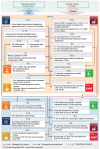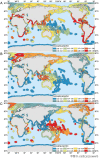Leveraging the metacoupling framework for sustainability science and global sustainable development
- PMID: 37305165
- PMCID: PMC10255777
- DOI: 10.1093/nsr/nwad090
Leveraging the metacoupling framework for sustainability science and global sustainable development
Abstract
Sustainability science seeks to understand human-nature interactions behind sustainability challenges, but has largely been place-based. Traditional sustainability efforts often solved problems in one place at the cost of other places, compromising global sustainability. The metacoupling framework offers a conceptual foundation and a holistic approach to integrating human-nature interactions within a place, as well as between adjacent places and between distant places worldwide. Its applications show broad utilities for advancing sustainability science with profound implications for global sustainable development. They have revealed effects of metacoupling on the performance, synergies, and trade-offs of United Nations Sustainable Development Goals (SDGs) across borders and across local to global scales; untangled complex interactions; identified new network attributes; unveiled spatio-temporal dynamics and effects of metacoupling; uncovered invisible feedbacks across metacoupled systems; expanded the nexus approach; detected and integrated hidden phenomena and overlooked issues; re-examined theories such as Tobler's First Law of Geography; and unfolded transformations among noncoupling, coupling, decoupling, and recoupling. Results from the applications are also helpful to achieve SDGs across space, amplify benefits of ecosystem restoration across boundaries and across scales, augment transboundary management, broaden spatial planning, boost supply chains, empower small agents in the large world, and shift from place-based to flow-based governance. Key topics for future research include cascading effects of an event in one place on other places both nearby and far away. Operationalizing the framework can benefit from further tracing flows across scales and space, uplifting the rigor of causal attribution, enlarging toolboxes, and elevating financial and human resources. Unleashing the full potential of the framework will generate more important scientific discoveries and more effective solutions for global justice and sustainable development.
Keywords: biodiversity; ecosystem services; human–nature interactions; planetary boundaries; sustainable development; telecoupling.
© The Author(s) 2023. Published by Oxford University Press on behalf of China Science Publishing & Media Ltd.
Figures









References
-
- UN Environment . Global Environment Outlook 6. Cambridge: Cambridge University Press, 2019.
-
- IPCC . Climate Change 2022: Impacts, Adaptation and Vulnerability. Contribution of Working Group II to the Sixth Assessment Report of the Intergovernmental Panel On Climate Change. In: Pörtner H-O, Roberts DC, Tignor Met al. (eds.). Cambridge and New York: Cambridge University Press, 2022.
-
- Clark WC, Harley AG. Sustainability science: toward a synthesis. Annu Rev Environ Resour 2020; 45: 331–86.10.1146/annurev-environ-012420-043621 - DOI
Publication types
LinkOut - more resources
Full Text Sources
